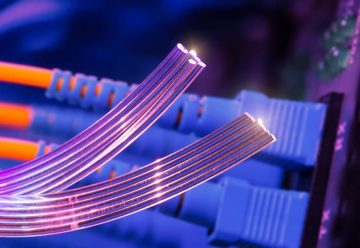There is a lot of conversation about fibre – but what exactly is the difference between dark fibre and lit fibre, and which one is right for you?
There are several pros and cons for choosing either Dark Fibre vs Lit Fibre.
What is Dark Fibre?
Dark Fibre is simply a length of fibre optic cable which has no equipment connected to it and is not transmitting any data. A business will lease or buy this fibre from a network provider and then fully manage the equipment, deployment, security, traffic and maintenance themselves.
Dark Fibre capacity is limitless and it’s easily scalable. As the whole fibre is leased by and dedicated entirely to that business, it means they use the capacity how they choose. That includes taking advantage of technology like Dense Wave Multiplex Divisioning (DWDM) where equipment at the end of the fibre can split the light out into the various wavelengths of the spectrum to carry data and increasing capacity significantly – up to 400Gbps across a single fibre using 88 channels.
What are the benefits of using Dark Fibre?
The benefits offered by Dark Fibre are compelling, particularly for larger organisations:
- Limitless capacity – so your future-proofed connection grows with your business and can handle large amounts of data
- Full control – use and scale your capacity how you like, configuring the network to meet your specific needs
- Complete security – your dedicated connection is not shared with anyone else and therefore less prone to security risks
- Cost savings – if you use large amounts of bandwidth, dark fibre can be less expensive than managed services
What is Lit Fibre?
In contrast to this choosing a ‘lit’ option puts the onus on the network provider who will then be responsible for keeping the fibre lit and ensuring availability and capacity. Lit services like Ethernet and Optical Wavelengths tend to come with a Service Level Agreement (SLA) which promises the business a certain level of availability and support – up to 99.95%. Capacity across Lit Fibre can scale from 10Gbps to 400Gpbs.
What are the benefits of using a layer 1 Lit Fibre service?
Whether Dark Fibre or Lit Fibre is best for your business will depend on your unique circumstances and needs. Lit Fibre also has its benefits:
- Swift set-up – getting Lit Fibre up and running doesn’t take as much time as Dark Fibre
- Less expense – although Lit Fibre still needs investment, it’s less costly than Dark Fibre
- Less responsibility – when you lease Lit Fibre, any maintenance and repairs will be undertaken by the carrier, not you
- Guaranteed availability – you’ll usually have a service level agreement with your carrier, putting the onus on them to ensure you’re always connected
Dark Fibre vs Lit Fibre
Whilst Lit Fibre lacks the ability to easily and quickly scale, the timescales of getting Dark Fibre set up are much longer and typically more costly.
With Dark Fibre, businesses are responsible for leasing the fibre as well as buying and maintaining the equipment and the IT staff needed to use the fibre. For Lit Fibre any downtime would be the issue of the carrier but can be a bit more restrictive in terms of routes as the fibre is already laid and connectivity to the premises depends on whether the network provider’s route runs there.
Dark Fibre and Lit Fibre offer very different options, so it is important to consider what is most important to your business – whether that is cost, diverse routing, dedicated bandwidth and the kind of levels of capacity and whether it will need scaling in the future.







